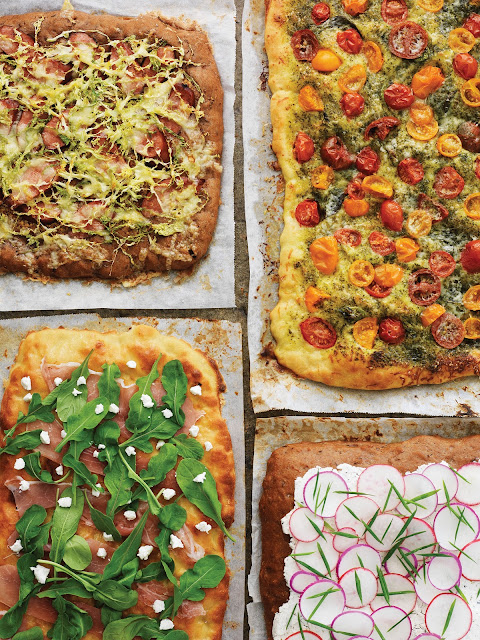Liederkranz Cheese and Sour Caraway Rye Flatbread
I grew up in a German/Irish town near Cincinnati, Ohio, where church sauerkraut suppers raised lots of money and fried sauerkraut balls were all the rage as appetizers.
(If you want the sauerkraut ball recipe, which is delicious, then leave your e-mail in a comment below and I’ll send it to you. They look like hush puppies but are much more flavorful.)
Hey, if you have even the tiniest speck of German ancestry, you have to love sour.
In German Village,
just south of Columbus, Ohio, you can eat your fair share of grilled bratwurst topped with kraut, washed down with a brew.
For those of us who come from German ancestry, "sour" in bread means a dark, tangy, sour rye that stands up to a frothy mug of beer and even the stinkiest cheese.
Reigning over the kingdom of Stinky Cheese is Liederkranz, which means “wreath of songs” in German. An Americanized version of the equally aromatic Limburger cheese, Liederkranz was made for generations in Van Wert, Ohio, just north of Dayton. The plant closed down in 1985, but now Liederkranz is being crafted again in Wisconsin.
My grandfather loved Liederkranz sort of sliced and squished on rye bread with chopped raw onion on top. “Wreath of songs” should have translated into “wreath of fumes” after eating, or sitting near someone eating, Liederkranz on rye.
For your Oktoberfest celebrations, why not make a sour rye flatbread that you just pat into a pan, then top it with sausage and chopped fresh Savoy cabbage or sauerkraut?
Liederkranz optional. . . .
That’s the good life!
Sausage and Cheese Flatbread (in the upper left corner of the photo)
Adapted from Heartland: The Cookbook by Judith Fertig.
Serves 12
1/2 recipe prepared No Knead Sour Caraway Rye Dough (below)
¼ cup Dijon or wholegrain mustard
1 pound smoked sausage links, cooked and cut into ½-inch slices
2 cups shredded Savoy cabbage or drained and rinsed sauerkraut
2 cups grated Gruyere or cave-aged Swiss cheese
1. Preheat the oven to 450°F. Place 2 cups of hot water in a broiler pan on the lower rack. Line a baking sheet with parchment paper.
2. With wet hands, pat the dough into a 10 x 16-inch oval on the prepared baking sheet. Spread the mustard over the dough. Arrange the sliced sausage, then the cabbage on the dough. Sprinkle with Gruyere.
3. Bake for 20 to 22 minutes or until, risen, browned, and firm to the touch. Let cool on the baking sheet. To serve, cut into slices.
No Knead Sour Caraway Rye Dough
Like many Heartlanders, rye works hard. This grain is disease-resistant and the hardiest of the cereal crops in the Dakotas, Nebraska, and Minnesota. Farmers plan winter rye, like winter wheat, by drilling seeds into the ground around September, then harvest in early summer. Rye is also a versatile crop, grown not only for the potential flour but also for holistic weed control, pasture for cattle during the winter months, and vodka. Quite a combo. Because rye is low in gluten, which is needed to develop the structure of bread, you use a combination of wheat and rye flours in bread dough. The rye bread flavor comes from caraway, the dark color from the cocoa powder, and gentle sourness from yogurt. Beloved of Heartland families with northern European roots, this rye dough can be turned into flatbreads, loaves, and rolls. If you precisely follow all the steps, you’ll have good success.
Makes breads, flatbreads, or rolls to serve 24 to 32
2 tablespoons instant or bread machine yeast
1 ½ tablespoons fine kosher salt
4 1/2 cups bread flour, plus more for dusting
2 cups rye flour
¼ cup unsweetened cocoa powder
2 tablespoons caraway seeds
1/2 cup sorghum or molasses
½ cup plain yogurt
2 1/4 cups lukewarm water, about 100°F
1. Spoon the flour into a measuring cup, level with a knife or your finger, then dump the flour into a 16-cup mixing bowl.
2. Add the yeast, salt, cocoa powder, and caraway seeds to the flour. Stir together with a wooden spoon or Danish dough whisk. Mix the sorghum, yogurt, and water together in a 4-cup measuring cup. Pour the molasses mixture into the flour mixture, stir to combine, then beat 40 strokes, scraping the bottom and the sides of the bowl, until the dough forms a lumpy, sticky mass.
3. Cover with plastic wrap and let rise at room temperature 72°F for 2 hours or until the dough has risen about 2 inches under the rim of the bowl and has a sponge-like appearance.
4. Use that day or place the dough, covered with plastic wrap, in the refrigerator for up to 3 days before baking. If you like, write the date on the plastic wrap, so you know the “bake-by” date of your dough.

No comments:
Post a Comment